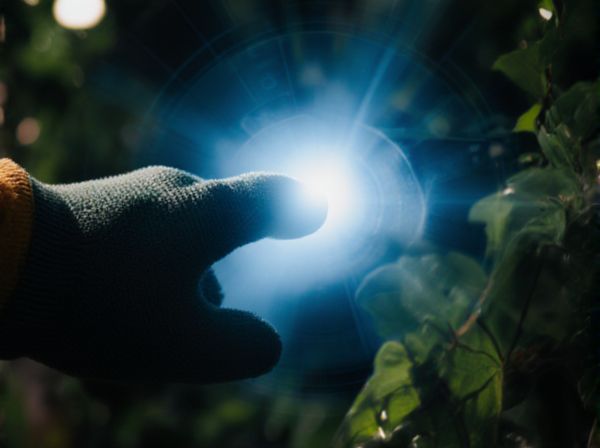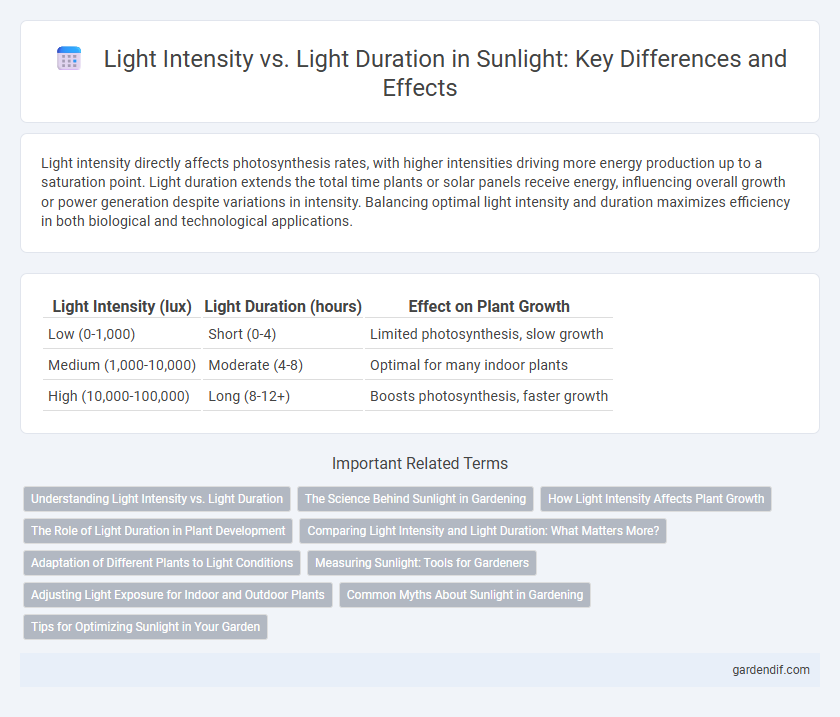
Light intensity vs light duration Illustration
Light intensity directly affects photosynthesis rates, with higher intensities driving more energy production up to a saturation point. Light duration extends the total time plants or solar panels receive energy, influencing overall growth or power generation despite variations in intensity. Balancing optimal light intensity and duration maximizes efficiency in both biological and technological applications.
Table of Comparison
| Light Intensity (lux) | Light Duration (hours) | Effect on Plant Growth |
|---|---|---|
| Low (0-1,000) | Short (0-4) | Limited photosynthesis, slow growth |
| Medium (1,000-10,000) | Moderate (4-8) | Optimal for many indoor plants |
| High (10,000-100,000) | Long (8-12+) | Boosts photosynthesis, faster growth |
Understanding Light Intensity vs. Light Duration
Light intensity measures the strength of sunlight received per unit area, directly influencing photosynthesis efficiency and plant growth rates. Light duration, or photoperiod, determines the total exposure time to light, affecting circadian rhythms and developmental processes in plants. Understanding the balance between light intensity and duration is essential for optimizing agricultural practices and indoor plant cultivation.
The Science Behind Sunlight in Gardening
Light intensity directly affects photosynthesis efficiency and plant growth rates, with higher intensity promoting more robust development. Light duration influences the photoperiodism that regulates flowering cycles and metabolic activities in plants. Understanding the balance between light intensity and duration is crucial for optimizing sunlight exposure to maximize garden productivity and plant health.
How Light Intensity Affects Plant Growth
Higher light intensity enhances photosynthesis rates, leading to increased plant growth and biomass accumulation. Excessive light intensity, however, can cause photooxidative stress, damaging chlorophyll and reducing growth efficiency. Optimal light intensity balances energy absorption and plant stress tolerance for maximum development.
The Role of Light Duration in Plant Development
Light duration plays a crucial role in regulating plant development by influencing processes such as photoperiodism, which determines flowering time and growth cycles. Extended light periods can enhance photosynthesis by increasing the total energy available, thereby promoting biomass accumulation and vegetative growth. Plants adapt to varying light durations by modulating hormone levels and gene expression, optimizing their development and reproductive success under different sunlight conditions.
Comparing Light Intensity and Light Duration: What Matters More?
Light intensity and light duration both crucially impact photosynthesis, but light intensity directly influences the rate of energy capture by chlorophyll molecules, determining how effectively plants convert sunlight into chemical energy. Extended light duration enhances total photosynthetic output by prolonging the active period for carbon fixation, yet without sufficient intensity, the energy levels remain suboptimal. Optimal plant growth requires balancing high light intensity with adequate duration to maximize photosynthetic efficiency and biomass accumulation.
Adaptation of Different Plants to Light Conditions
Plant adaptation to varying light intensity and duration involves physiological and morphological changes that optimize photosynthesis efficiency. Shade-tolerant species develop larger, thinner leaves with higher chlorophyll content to capture low light, while sun-loving plants produce thicker leaves with more stomata to maximize gas exchange under high light intensity. Differences in photoperiod sensitivity allow plants to time growth cycles and flowering according to daylength, ensuring survival in diverse light environments.
Measuring Sunlight: Tools for Gardeners
Measuring sunlight accurately involves evaluating both light intensity and light duration, crucial factors for healthy plant growth. Tools like light meters measure light intensity in lux or foot-candles, while photometers and solar timers track the duration of sunlight exposure throughout the day. Combining data from these instruments helps gardeners optimize plant placement and ensure appropriate light conditions for various species.
Adjusting Light Exposure for Indoor and Outdoor Plants
Optimizing light exposure for indoor and outdoor plants requires balancing light intensity and duration to maximize photosynthesis and growth. Indoor plants benefit from longer light duration with moderate intensity using artificial grow lights, while outdoor plants thrive under natural sunlight with higher intensity but variable duration. Monitoring and adjusting these factors help prevent light stress and promote healthy development.
Common Myths About Sunlight in Gardening
Light intensity and light duration are often misunderstood in gardening, with many believing that longer sunlight exposure always benefits plant growth. However, excessive light duration combined with high intensity can cause leaf burn and stress in many common garden plants, reducing overall health. Optimal gardening sunlight requires balancing moderate light intensity with appropriate exposure times tailored to each plant species.
Tips for Optimizing Sunlight in Your Garden
To optimize sunlight in your garden, prioritize maximizing light intensity by planting sun-loving species in areas with direct, unobstructed exposure for at least six hours daily. Extend effective light duration by using reflective surfaces or pruning nearby foliage that blocks sunlight, enhancing photosynthesis efficiency. Monitor seasonal changes to adjust plant placement or introduce supplementary lighting for consistent growth and health.
Light intensity vs light duration Infographic

 gardendif.com
gardendif.com